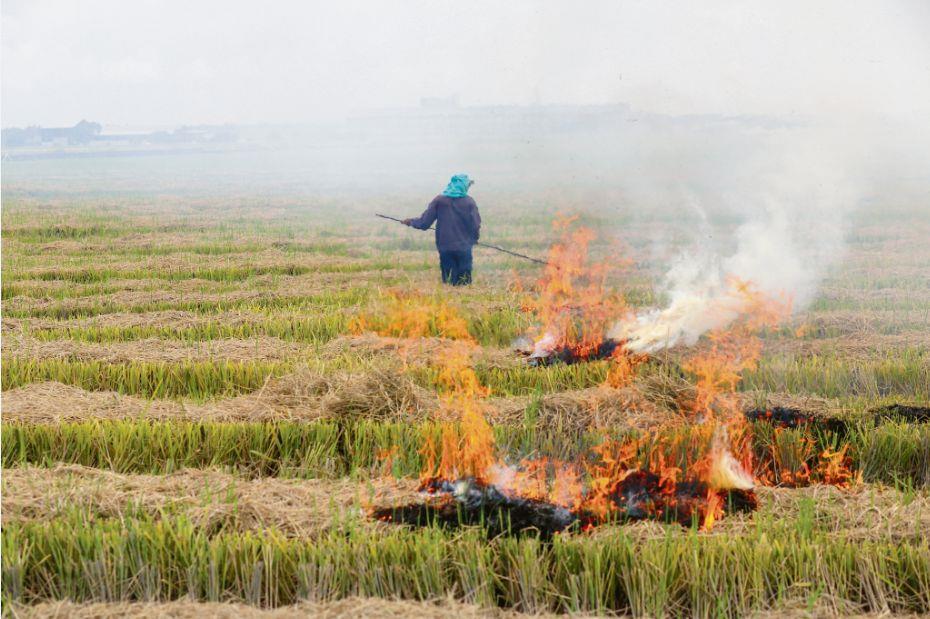
Farmers say they don’t have any financially viable option to dispose of the stubble.
Sanjeev Singh Bariana
HARVESTING has commenced for the paddy crop and so has the burning of its stubble. The government machinery is counselling farmers and informing them about the availability of straw management machinery to curb farm fires. However, farmers and farm unions are saying that they do not have any financially viable option to dispose of the stubble, so the farm fires will continue this year.
A senior officer, requesting anonymity, admits: “Nothing can stop stubble burning until all parties, including the department of agriculture, the Punjab Pollution Control Board (PPCB) and the farmers work out an acceptable-to-all solution. Any solution, ultimately, will need the nod of the Centre. And this does not look like happening.”
A farmer from Lehra Bega village in Bathinda district, Gurtej Singh, says, “Fires have already started and you will see them all over Punjab in the coming days. We are made to spend extra on clearing stubble from our fields after the harvest, without any financial support, which makes farming unviable. We need machines and labour.”
Official figures say the government provided about 51,000 machines on subsidy under the Crop Residue Management Scheme for the management of paddy residue during 2018-19 and 2019-20. Dr Manjit Singh, head of department of farm machinery at Punjab Agricultural University (Ludhiana), says the state government has received about 77,000 applications this year for just 23,500 machines, showing greater interest among farmers for the stubble disposal machines.
Experts say the state has about 200 lakh tonnes of paddy stubble to manage each year. Going by the sheer volume of the work, farmers need to be incentivised by the government. Member secretary, PPCB, Karunesh Garg, says, “It is too early to give any figures for the farm fires this year. Data formulation will start around September 23.”
Data from NASA shows that in November 2016, the number of crop residue fires was 51,150 in Punjab, but it came down to 28,078 next year during the same period. It rose to 39,231 in 2018 and fell to 26,260 in 2019. There were reports of rampant burning of wheat stubble in April-May this year.
Delhi has been complaining for long about the bad quality of its air during particular months. Punjab is blamed as the biggest offender. Punjab’s fires are bigger in number compared to adjoining states primarily because the area under paddy cultivation is more. In 2018-19, the area was 31 lakh hectares, while in Haryana it was 14.45 lakh hectares. This year, Punjab has about 27 lakh hectares under paddy.
Bharti Kisan Union (Ugrahan) leader Ram Singh Bhainibaga says, “Unless there are financially viable alternatives for the already distressed farmers, paddy stubble will be burnt. We have time and again demanded a bonus of Rs 200 per quintal for the crop residue, which works to be about Rs 6,500 per acre. Otherwise, at the current rate of payment, a farmer saves little.”
Farmers who are found burning paddy are liable to be booked under Section 188 (disobedience to order promulgated by a public servant) of the Indian Penal Code. An offender can be sentenced to a term of one month along with a fine.
A senior officer says in 2019, 3,141 challans were issued for recovering around Rs 40 lakh on account of burning paddy. As many as 322 farmers were booked under FIRs. And a red pen entry was made against the names of 510 farmers, which means that they will not be able to avail special government benefits in future.
The state has earmarked special sites in the districts for the collection of crop residue on common land/cattle pounds and gaushalas where farmers can store paddy straw. This stored basmati residue can be transported to places where it can be used as cattle fodder. The state already has 11 biomass power projects generating 97.50 MW. These are consuming about 8.8 lakh metric tonnes of paddy residue per annum.
At least two more projects are planned. Eight bio-CNG and one bio-ethanol projects, using paddy straw, are likely to be commissioned between March 2021 and December 2022.
Send your feedback to [email protected]
Join Whatsapp Channel of The Tribune for latest updates.



























